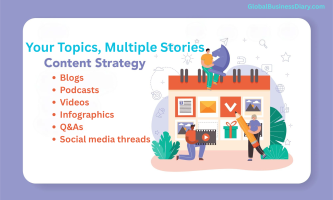Adapting To Consumer Expectations: Personalisation In Digital Advertising

The shift towards digital has transformed advertising from a broad-based approach to a highly personalized interaction between brands and consumers. This evolution reflects a deeper understanding of consumer behavior and preferences, facilitated by advances in technology and data analytics. Personalization in digital advertising is not just about tailoring ads to individual users but about creating meaningful connections that enhance the consumer experience and drive engagement.
Understanding Consumer Expectations in the Digital Age

Today’s consumers expect more from brands. They seek relevance in the messages they receive and are willing to engage more if these communications reflect their personal interests, needs, and lifestyles. This demand for personalized content has set a new standard for digital advertising, pushing brands to innovate and adapt. Consumers now favor brands that demonstrate an understanding of their unique preferences, making personalization a critical element in building and maintaining customer relationships.
The Role of Data in Crafting Personalised Experiences

Data is at the heart of personalized advertising. By collecting and analyzing consumer data, brands can gain insights into individual preferences and behaviors. This information, ranging from browsing habits to purchase history, enables advertisers to deliver content that resonates with each consumer. However, with great power comes great responsibility. Brands must navigate the delicate balance between personalization and privacy, ensuring that they use data ethically and transparently to build trust with their audience.
Technological Innovations Shaping Personalised Advertising

Innovation in technology has paved the way for advanced personalization strategies. Artificial intelligence (AI) and machine learning algorithms can sift through vast amounts of data to identify patterns and predict consumer preferences with remarkable accuracy. These capabilities allow for the dynamic personalization of advertising content, ensuring that the right messages reach the right audience at the right time. Furthermore, brand suitability solutions have emerged as a vital
component of personalised advertising. These solutions ensure that ads appear in contexts that align with a brand’s values and the audience’s expectations, thereby enhancing the effectiveness of advertising campaigns and safeguarding brand reputation.
The Impact of Personalisation on Consumer-Brand Relationships

Personalized advertising has a profound impact on the relationship between consumers and brands. When brands successfully deliver personalized content, they not only meet the immediate needs of their audience but also foster a sense of belonging and loyalty. This relationship-building is crucial in today’s competitive market, where consumers have endless choices at their fingertips. Personalized advertising can differentiate a brand, making it more memorable and increasing the likelihood of repeat engagements and transactions.
Best Practices for Brands Embracing Personalized Advertising
For brands looking to harness the power of personalized advertising, there are several best practices to consider. First, prioritizing data privacy and security is essential. Clear communication about how consumer data is used and ensuring compliance with data protection regulations can help maintain consumer trust. Second, brands should invest in the right technology and expertise to analyze data effectively and create personalized experiences. Finally, continuous testing and optimization of personalized advertising campaigns are crucial. By regularly assessing the performance of their campaigns, brands can refine their strategies to better meet consumer needs and expectations.
In conclusion, personalization in digital advertising represents a significant shift in how brands interact with consumers. By focusing on individual preferences and behaviors, brands can create more engaging and effective advertising campaigns. However, success in this area requires a commitment to understanding consumers, leveraging technology, and respecting privacy. As brands navigate the complexities of personalization, those that master these elements will be well-positioned to build stronger relationships with their customers and achieve greater success in the digital age.
Benefits of personalization in digital advertising

When we are discussing digital advertising, personalization can have a lot of benefits for organizations. Let’s have a look at what those are:
- One of the most significant changes it can bring is that it can increase sales and conversions. Creating advertising that is specifically tailored to meet the customers’ interests and needs will get the companies a positive response from the customers.
For instance, if the customer expresses interest in one particular product, they will be more inclined to click on an ad for the product and then buy the item.
- Another one of the benefits of personalization is that it helps in building strong relationships with customers. Suppose you make your customers feel that you genuinely understand them and are looking after their specific wants and needs. In that case, there is a chance that they are going to be your loyal customers.
This is going to lead to repeating business and getting positive mouth-to-mouth recommendations as well. This is something invaluable for any business.
- Personalization also helps you stand out from the other businesses that are your competition. Every company is throwing so many advertisements at customers every day that it becomes challenging to make an actual impact on an audience.
But if you are personalizing the advertisements, you make your message stand out from the other ones that are circulating in the market. This way, the advertisements will be more memorable for the customers.
- Along with that, personalization helps companies save money on their efforts to make advertisements, as they are more efficient with the amount they are spending on advertising.
They target only the relevant audience and focus on their resources on that audience, which is going to convert and will not go to waste. They do not spend the advertisement on those whom the ad will not impact.
What is the future of personalization in digital advertising?
The future of digital advertising with personalization is quite an exciting and rapidly growing field. Data and technology are advancing with changing times, and companies are looking for new ways to personalize their efforts and also connect with their audience more.

One of the trends that is going on these days is the use of AI and other machine learning in
personalization. These new technologies are going to become more sophisticated and advanced. This will allow companies to look into even more data and form more personalized and tailored experiences for the customers.
Making use of smart speakers and voice assistants for personalization is also going to be more prevalent. Companies would be able to use these devices to deliver offers and personalized ads and recommend products to customers more intuitively and naturally.
It is also expected that personalization will go beyond traditional advertising and get involved in other areas of customer experience. Companies are going to use personalization to provide personalized customer service, personalized pricing, and even personalized product recommendations.
However, as this evolves, the ethical considerations are also going to become. Companies have to make sure that they are transparent about using and collecting data and allow customers to have control over the personalized experience they are given.
MORE FOR YOU:













